In the first half of 2024, the art world continued to celebrate the vibrant and iconic works of Keith Haring. Renowned for his bold lines, radiant colors, and dynamic figures, Haring's pieces have long captivated collectors and enthusiasts alike. This period saw several of his masterpieces fetching impressive sums at auction, reflecting both his enduring influence and the consistent demand for his art. As we delve into the top-selling works of this prolific artist, we uncover the pieces that have not only garnered significant financial success but also reaffirmed Haring's legacy in the contemporary art market.

Dog
price realised: $454,557
sold by Phillips London
June 6, 2024
Throughout his career, Haring addressed controversial and taboo subjects such as social injustice, AIDS, the drug crisis, and racism, using his unique iconography. Embedded in the fast and decadent culture of 1980s New York, his work bridged high and low culture, blending graffiti, semiotics, and the art historical canon. By elevating primitive stick figures and cartoon characters to the level of high art, Haring sought to democratize art, championing the individual and standing up for the oppressed.
Visually assertive, the bright yellow paint combined with the shine of black silkscreen ink in Dog acts as a warning sign. The X-branded men, television sets, and transgressive images of men and dogs emphasize the primal instincts within each of us. The dizzying frenzy of the work's interior, filled with Haring's picture-words, creates a fluid sentence that moves from the crawling baby in the lower left foot—an emblem of a positive future—to anthropomorphic dogs dancing on top of men, reflecting both Egyptian concepts of life and death and Christian notions of the dance of the dead.
Scattered throughout are human targets branded by the letter X, including one involved in explicit liaisons with a dog in the foot of the right leg and another at the very top, where a winged man or angel—symbolizing death and the battle of good against evil—rides a dog, with the X sealing their fates. These symbols resonated deeply with those living through the AIDS epidemic in New York City. As a gay man, Haring's life and work were entrenched in this community, making him a significant advocate for AIDS activism.
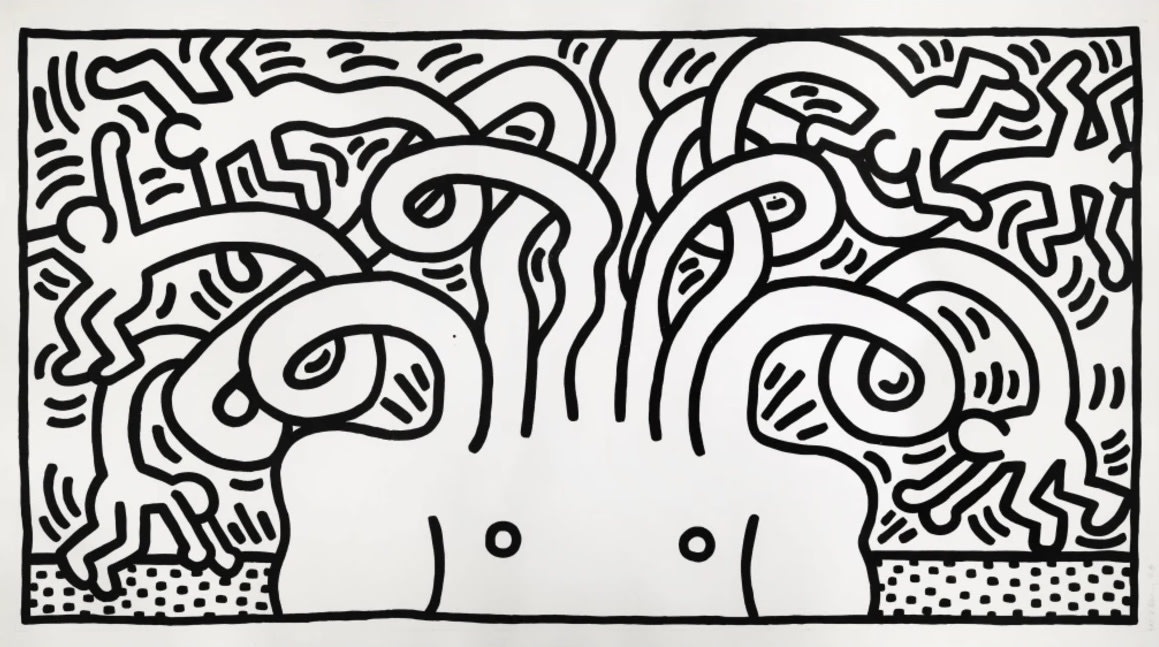
Untitled (Medusa)
price realised: $151,200
sold by Christie's New York
April 16, 2024
Keith Haring's Untitled (Medusa) is a striking work that exemplifies his unique ability to fuse classical mythology with contemporary social commentary. In this piece, Haring reinterprets the myth of Medusa, traditionally depicted as a monstrous figure with snakes for hair whose gaze could turn people to stone. Haring's rendition of Medusa retains this iconic imagery but infuses it with his distinctive style characterized by bold lines, vibrant colors, and dynamic figures.
Haring's Medusa is not merely a retelling of an ancient myth but a potent symbol of the societal fears and anxieties of the 1980s. The writhing snakes and intense expression on Medusa's face can be seen as a reflection of the chaotic and often hostile social environment of the time, marked by the HIV/AIDS crisis, rampant drug abuse, and political turmoil. Haring's use of Medusa, a figure capable of paralyzing her victims with a glance, could symbolize the paralyzing fear and stigma associated with these issues.
The artwork's composition is typical of Haring's style, with a dense arrangement of figures and shapes that convey a sense of movement and urgency. The vivid colors and energetic lines draw the viewer's eye, creating a visual experience that is both captivating and unsettling. By merging the ancient with the modern, Haring creates a timeless piece that speaks to universal themes of fear, power, and transformation.

Dog
price realised: $120,630
sold by Phillips London
January 17, 2024
Encompassed within the shape of Haring’s human-like standing dog figure is a chaotic scene of stick figures, televisions, dogs, humanoids and deformed animals, providing the viewer with a glimpse of Hell. The figures are shown devouring and clambering on top of one another, with a devil-like figure spreading its wings at the top of the image. This dizzying frenzy of pictograms speaks to Haring’s feelings surrounding the socio-political events that characterised 1980s New York like the HIV/AIDS epidemic, the Cold War and crack epidemic.

Pop Shop IV
price realised: $113,400
sold by Christie's New York
April 16, 2024
Keith Haring's Pop Shop IV is a vibrant and dynamic print filled with bright block colors and the artist's signature graphic style. This piece brings together some of Haring's most famous iconography, including the barking dog, radiant child, and winged angel and devil-like figures. These motifs, rendered in thick black outlines and highly simplified forms, are instantly recognizable for their originality and playfulness.
Typical of Haring's street art style, which he developed in the early 1980s in the blank advertisement spaces of New York's subway, Pop Shop IV features bold, expressive lines and a vibrant color palette reminiscent of advertising. These early experiments in public spaces resulted in the distinctive style and iconography for which Haring would become world-famous.
Pop Shop IV not only showcases Haring's artistic talents but also his dedication to social activism. The playful yet powerful imagery in this print conveys themes of unity, love, and social justice, which were central to Haring's work. As with many of his pieces, Pop Shop IV is a celebration of life and humanity, created just a few years before HARING'S death from AIDS in 1990.
This print is a testament to HARING'S enduring legacy as an artist who blurred the lines between high art and popular culture, making his work accessible and meaningful to a global audience. Pop Shop IV remains a beloved and iconic piece that captures the essence of HARING'S artistic vision and his commitment to social change.

William S. Burroughs Apocalypse
price realised: $111,391
sold by Christie's Online
March 27, 2024
Keith Haring's William S. Burroughs Apocalypse is a striking series that merges the visual dynamism of HARING'S art with the provocative, free-form text of William S. Burroughs. The origins of this collaboration trace back to 1978 when Haring, then a student at the School of Visual Arts, encountered the Nova Convention, a gathering of Beat poets and downtown artists including Burroughs, Allen Ginsberg, Laurie Anderson, and Patti Smith. This pivotal moment led Haring to delve into Burroughs and Brion Gysin's 1977 book The Third Mind, which detailed methods of breaking down language—a technique that profoundly influenced HARING'S artistic approach.
Haring adopted the "cut-up" method described in The Third Mind, integrating it into his distinctive visual style in 1980. This approach allowed HARING to develop a unique form of pictorial communication that transcended traditional language, expressing complex and paradoxical themes such as life and death, religion and sexuality, heaven and hell, and political activism versus conformity. His influences, particularly evident in this series, include Dante Alighieri’s Inferno and Hieronymus Bosch’s The Garden of Earthly Delights.
In the Apocalypse series, created with Burroughs, HARING responds to Burroughs’ free-form text by collaging symbols of mass consumerism, religion, art, and advertisements. These elements serve as the foundation upon which Haring creates his iconic imagery using a stream-of-thought line technique. The series, produced in 1988, the year Haring was diagnosed with AIDS, poignantly reflects the turmoil, struggles, and complexities of life at that time within the New York downtown community, which had been heavily impacted by the AIDS epidemic.
The imagery in Apocalypse is dense and multifaceted, featuring computers, spermatozoa, devils, halos, divine light, and radiance. These symbols encapsulate the juxtaposition of euphoria and fear, torment, and illusory bliss, mirroring the chaotic and uncertain reality of that era. Burroughs’ text, printed on acetate film and segmented into fragmented words, heightens these polemics, resonating with contemporary themes as strongly as they did in 1988.
Haring's William S. Burroughs Apocalypse stands as a powerful testament to the collaboration between two visionary artists. It explores the depths of human experience through a blend of visual and textual elements, making it a significant and enduring work in HARING'S oeuvre. This series not only reflects HARING'S personal struggles and societal observations but also underscores his commitment to pushing the boundaries of artistic expression.
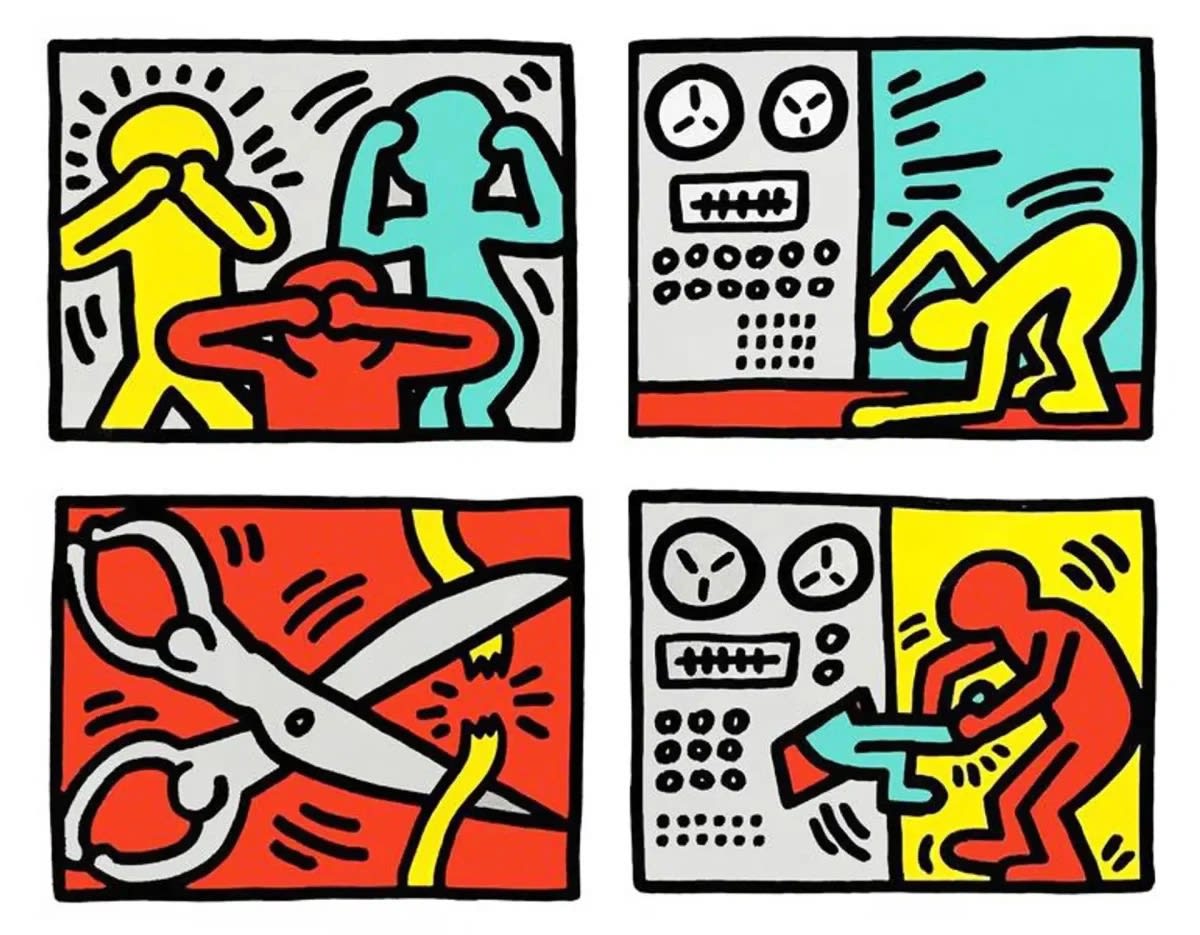
Pop Shop III
price realised: $108,412
sold by De Vuyst
March 2, 2024
Keith Haring's Pop Shop III suite, as depicted in the image, showcases his signature style of bold lines, vibrant colors, and dynamic figures. This series, created in 1989, is part of the larger Pop Shop series that Haring developed to make his art accessible to a wider audience.
The Pop Shop III suite includes four distinct panels, each filled with HARING'S iconic imagery. The first panel features three figures covering their eyes, ears, and mouth, evoking the proverbial "see no evil, hear no evil, speak no evil." The second panel shows a figure interacting with what appears to be a piece of machinery, bending down as if in submission or struggle. The third panel depicts a large pair of scissors cutting through a yellow figure, symbolizing destruction or severance. The fourth panel returns to the theme of machinery, with a red figure seemingly manipulating another figure through the device, hinting at themes of control and manipulation.
HARING'S use of bright, block colors and thick black outlines is reminiscent of his early street art, developed in the blank advertisement spaces of New York's subway system. The imagery in Pop Shop III is both playful and thought-provoking, addressing themes of censorship, technological control, and societal pressures.
This suite, like the rest of the Pop Shop series, reflects HARING'S commitment to making art accessible to everyone, breaking down the barriers between high art and popular culture. The Pop Shop itself, a store Haring opened in downtown Manhattan in 1986, sold affordable art merchandise, making his work available to a broader audience. The Pop Shop III suite remains a celebrated part of HARING'S oeuvre, embodying his ethos of accessibility and inclusivity in art.
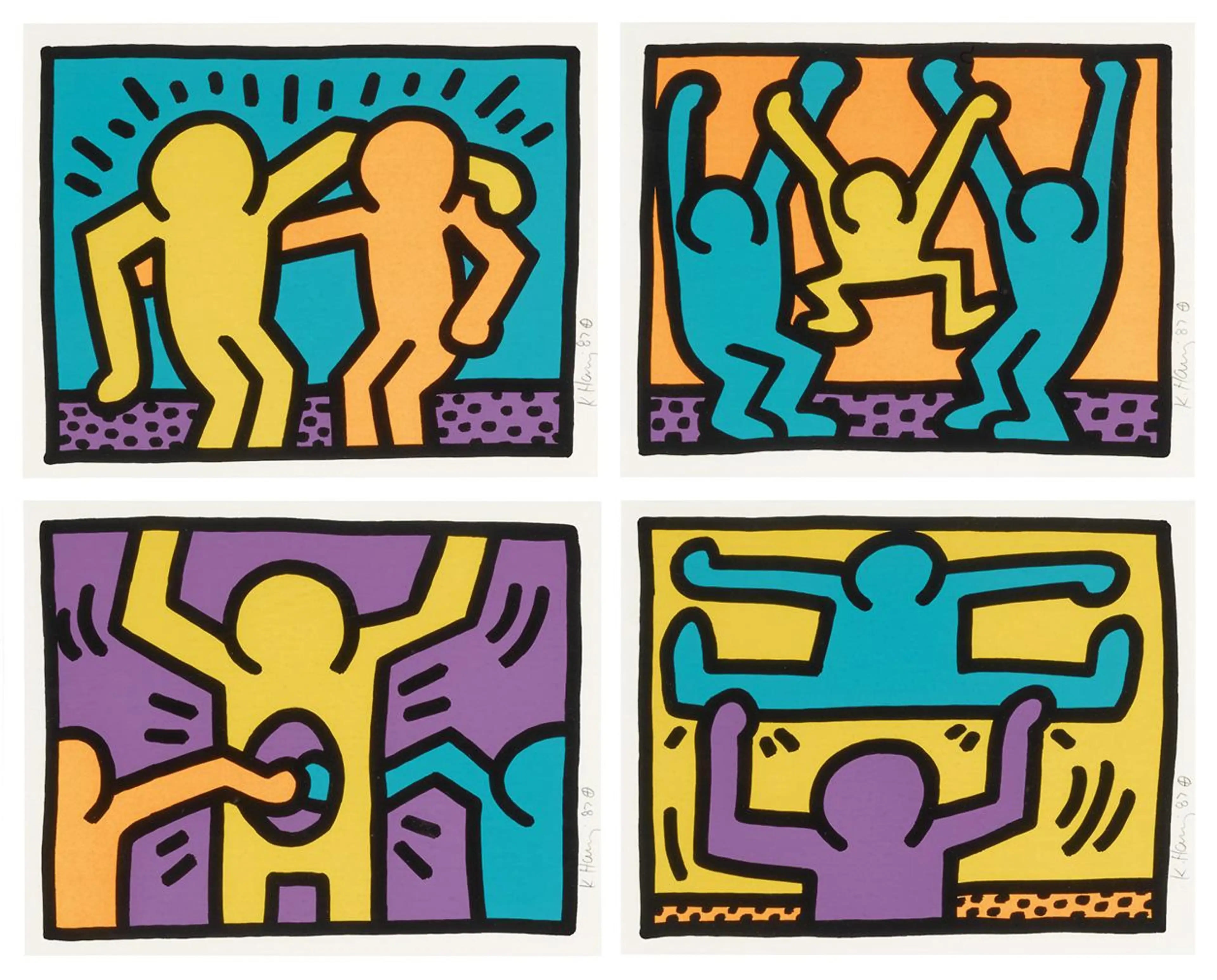
Pop Shop I
price realised: $107,100
sold by Los Angeles Modern Auctions
January 10, 2024
Keith Haring's Pop Shop I is part of a series of screenprints that embody his distinctive artistic style and his commitment to making art accessible to a wider audience. Created in 1987, the Pop Shop I suite features four panels, each filled with HARING'S iconic imagery and vibrant colors.
HARING'S use of bright, block colors and thick black outlines is characteristic of his work and reminiscent of his early street art, developed in the blank advertisement spaces of New York's subway system. The imagery in Pop Shop I is both playful and thought-provoking, addressing themes of human connection, support, and communal celebration.
The Pop Shop, which Haring opened in downtown Manhattan in 1986, was designed to bring his art to a broader audience by selling affordable merchandise like posters, T-shirts, and badges. The Pop Shop series, including Pop Shop I, reflects HARING'S belief in the democratization of art, breaking down barriers between high art and popular culture.
Pop Shop I remains a celebrated part of HARING'S oeuvre, embodying his ethos of accessibility and inclusivity in art. The suite continues to resonate with viewers today, highlighting HARING'S enduring impact on the art world and his role as a pioneer in bringing art to the masses. Through the Pop Shop series, Haring extended his reach, spreading his message and artistic vision to a global audience, and Pop Shop I is a testament to his ability to convey powerful ideas through simple, yet striking, visual forms.
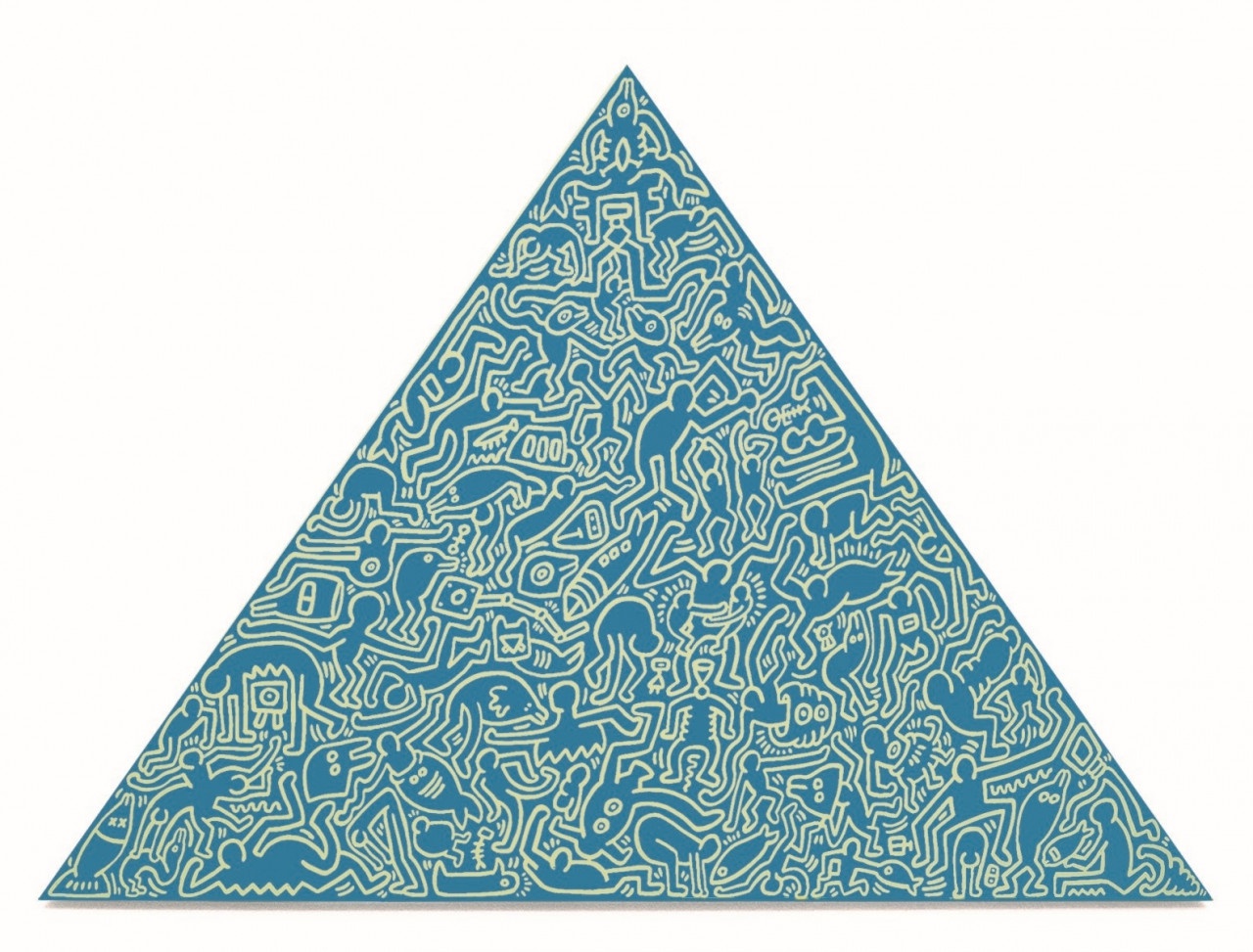
Pyramid
price realised: $96,504
sold by Phillips London
January 17, 2024
Keith Haring's Pyramid stands as a testament to his dedication to creating a universal visual language through his artwork. By foregrounding the pyramid, Haring emphasized his relentless effort in crafting modern hieroglyphics. His simple, outlined figures, combined with the pyramid, create an iconography that transcends language, class, sexual, and gender barriers, making it universally legible and relatable.
In Pyramid, Haring confronts the 'othering' of certain groups in society. The pyramid is adorned with a myriad of figures and hellish creatures, symbolizing the threats of the AIDS epidemic to mankind. This visual symbol demands viewers to take a closer look and contemplate the scene, shifting their perception and urging them to take action. HARING'S outlined figures are famously genderless, raceless, and classless, making them instantly relatable and representative of both the strengths and pitfalls of humanity.
Pyramid further explores these themes, representing the vices and virtues of mankind. The pyramid is filled with a flurry of HARING'S archetypal figures, conveying powerful moral stories through images alone. Each figure and creature within the pyramid tells a part of the broader narrative, showcasing the complexities and dualities of human nature.
Though Haring is best known for his bold and lively prints, many of his works pay homage to ancient civilizations, their iconography, and their crafts. The motif of the pyramid in his work reflects his desire to emulate ancient visual symbols and create an iconography that is not only universally legible but also timeless. HARING'S pyramids invite viewers to reflect on the human condition, societal issues, and the importance of empathy and understanding.
Through Pyramid, HARING'S artwork continues to resonate, encouraging contemplation and action, and highlighting his enduring legacy as an artist who bridged the ancient with the modern in a way that remains relevant and impactful long after his death.
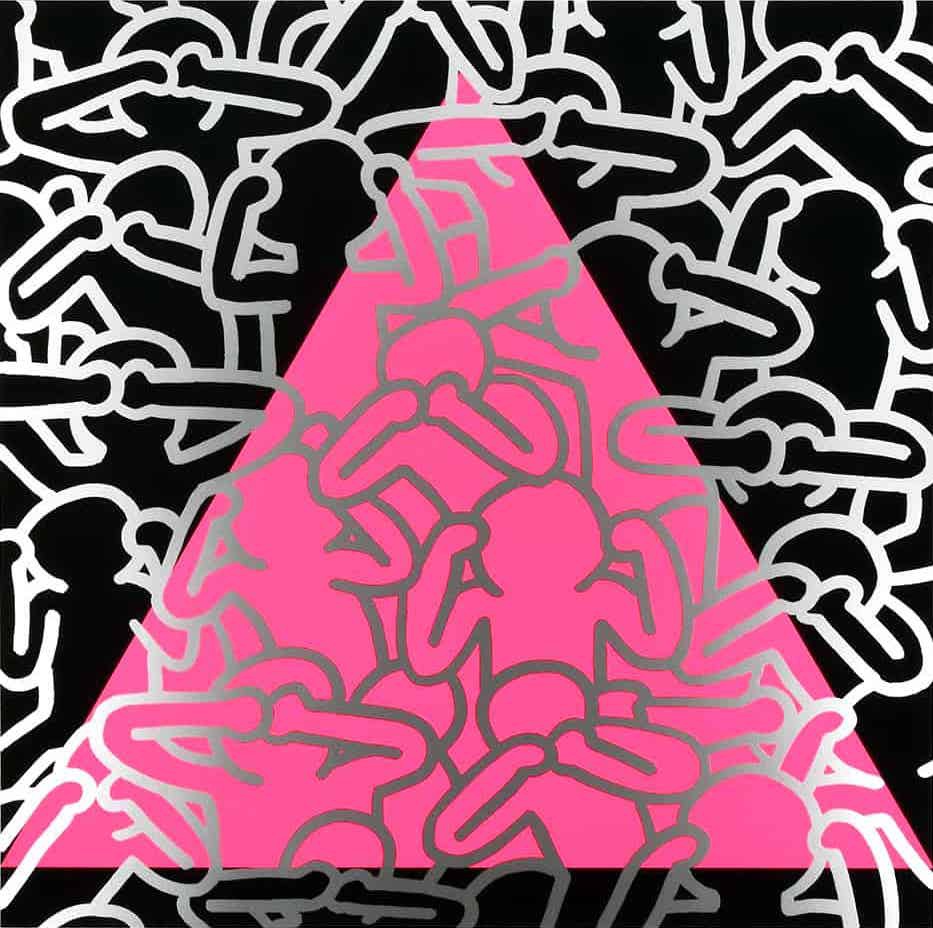
Silence = Death
price realised: $76,700
sold by Bonhams Los Angeles
March 26, 2024
Keith Haring's Silence = Death is a powerful and evocative work created in 1988, the same year the artist was diagnosed with AIDS. This seminal piece reflects HARING'S deep-seated opinions on the AIDS crisis, bringing his social activism to the forefront of his art. The painting features HARING'S iconic figures, all covering their ears and eyes, symbolizing the refusal to acknowledge the reality of the epidemic. Positioned above these figures is a pink triangle, a poignant and historically loaded symbol.
The pink triangle was originally used in Nazi Germany to identify and persecute gay people. By incorporating this symbol into his work, Haring draws a stark comparison between the treatment of LGBTQ+ individuals in WWII Germany and 1980s America. This parallel underscores the pain of being marginalized and ignored during a time of severe need. Haring felt the deep injustice of a society that, due to its homophobic tendencies, left behind a significant demographic in the face of the AIDS crisis.
Silence = Death adapts the pink triangle featured in a 1987 poster produced by the Silence=Death collective and popularized by the activist organization ACT UP. Haring overlays this triangle with figures enacting the pictorial maxim "See no evil, Hear no evil, Speak no evil," directly alluding to the Reagan administration's refusal to acknowledge or address the AIDS epidemic. This visual metaphor criticizes the government's negligence and the societal discomfort surrounding the disease.
In the final year of his life, HARING'S work increasingly centered on social activism, using his art to call for awareness, empathy, and action. Silence = Death stands as a testament to his commitment to these causes and his ability to convey powerful messages through his distinctive visual language. This painting remains a poignant reminder of the human cost of silence and the enduring need for advocacy and compassion.
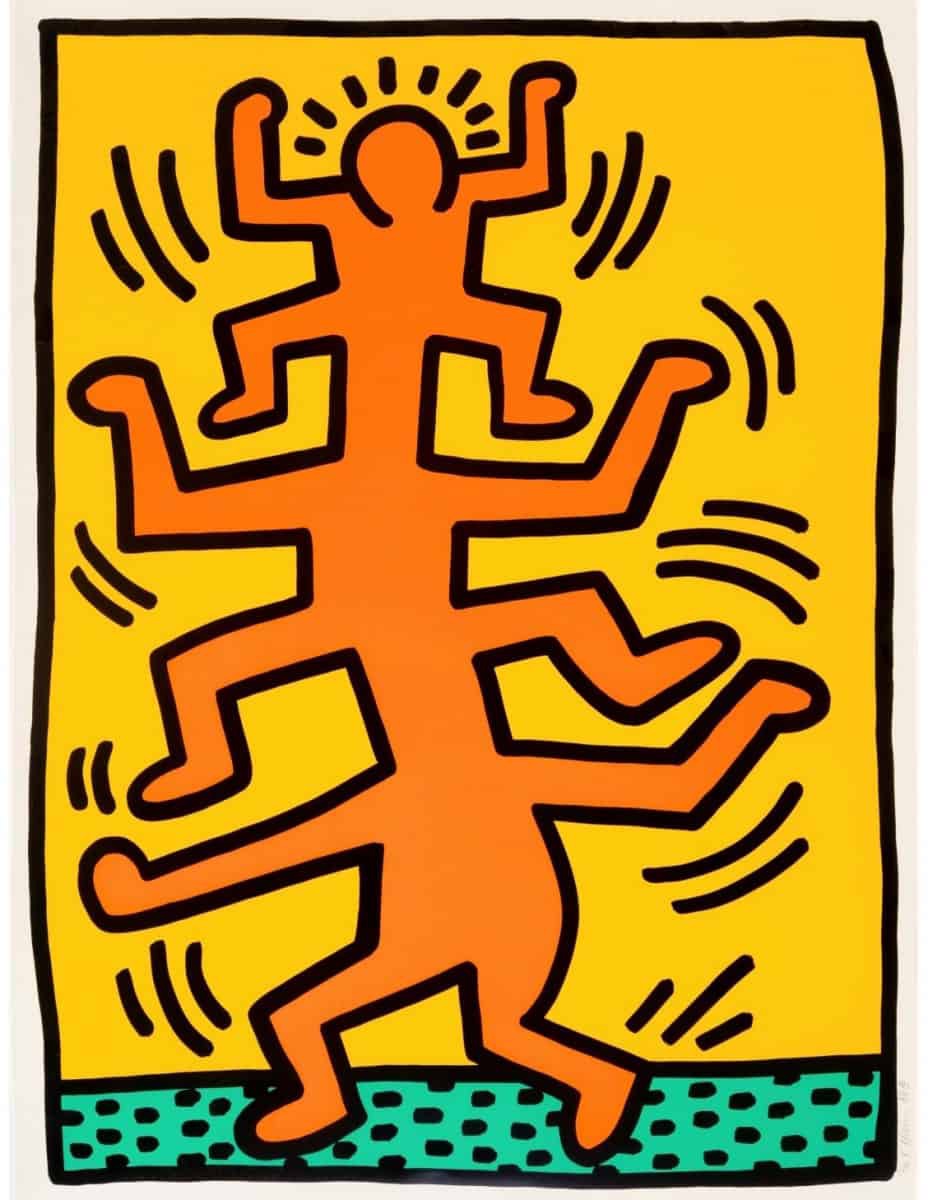
Growing: One Print
price realised: $75,600
sold by Christie's New York
April 16, 2024
Keith Haring's Growing 1 is a vibrant and dynamic piece that features his signature use of bold lines and bright colors. The artwork prominently displays the "people ladder" motif, which is a recurring theme in HARING'S work. This motif, characterized by stacked human figures, reflects themes of unity, collaboration, and collective strength.
In Growing 1, the figures are shown in a vibrant orange, with the background in a contrasting bright yellow, creating a striking visual impact. The figures appear to be interconnected, climbing on top of each other to form a human ladder. This imagery is symbolic of growth, support, and the interconnectedness of humanity. The movement and energy in the piece convey a sense of progress and upward momentum.
The "people ladder" motif is significant in HARING'S oeuvre as it encapsulates his belief in the power of community and the importance of mutual support. By depicting figures lifting and supporting one another, Haring emphasizes the idea that collective effort and solidarity are essential for overcoming challenges and achieving growth. This theme resonates with HARING'S broader social and political messages, as he often used his art to advocate for unity, equality, and social justice.
Haring's Growing 1 not only exemplifies his distinctive artistic style but also serves as a powerful reminder of the importance of community and collaboration. The artwork's vibrant colors and dynamic composition draw viewers in, encouraging them to reflect on the significance of supporting one another and working together towards common goals. Through this piece, Haring continues to inspire and engage audiences, highlighting the enduring relevance of his artistic vision and social commentary.

